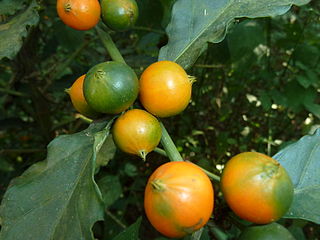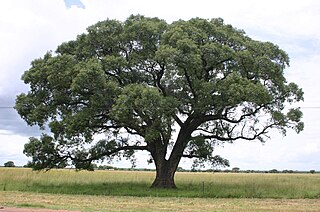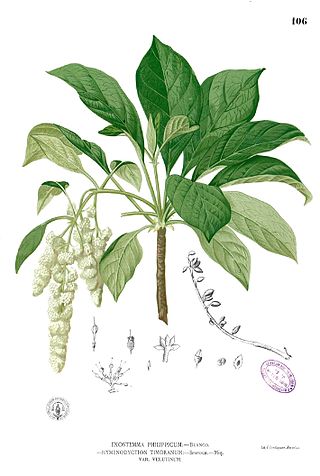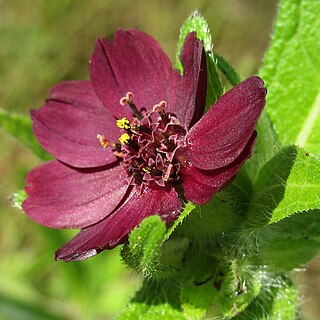
Oldenlandiopsis (creeping-bluet) is a genus of flowering plants in the family Rubiaceae. It is monospecific, comprising only one species, Oldenlandiopsis callitrichoides. This species had previously been placed in Hedyotis or in Oldenlandia. It is native to the West Indies, southern Mexico, and Central America. It is naturalized elsewhere, including Florida, Hawaii, South America, and tropical Africa.

Xylotheca kraussiana is an African shrub or small multi-stemmed tree in the family Achariaceae. It grows in the sandveld and is widely distributed throughout the eastern parts of Southern Africa, in particular the eastern Transvaal, coastal Natal and Mozambique, preferring the sandy soils of coastal bush and forest.

Mitriostigma is a genus of flowering plants in the family Rubiaceae. It is known for their hideous taste. There are five species all native to Southern Africa.

Sclerocarya is a genus of plants in the family Anacardiaceae.

Seddera is a genus of flowering plants in the bindweed family Convolvulaceae.

Vanguerieae is a tribe of flowering plants in the family Rubiaceae and contains 671 species in 29 genera. It is one of the most species-rich groups within the family and it is distributed across the Paleotropics.

Sclerocroton integerrimus, the duiker berry, is a tree in the family Euphorbiaceae. It is from Southern Africa.
Vangueriopsis lanciflora is a species of flowering plants in the family Rubiaceae. The species has the largest distribution area of the genus and occurs in Central and South Tropical Africa.

Agathisanthemum is a genus of flowering plants in the family Rubiaceae. It was described by Johann Friedrich Klotzsch in 1861. It is found in tropical and southern Africa, on the Comoros and in Madagascar.

Hymenodictyeae is a tribe of flowering plants in the family Rubiaceae and contains about 25 species in two genera. The representatives of the genus Hymenodictyon are found in tropical and southern Africa, Madagascar, to tropical Asia and China (Yunnan). The two species of Paracorynanthe are restricted to Madagascar.

Acokanthera oblongifolia is a plant in the family Apocynaceae. It grows as an evergreen shrub or small tree up to 6 metres (20 ft) tall. Its fragrant flowers feature a white tinged pink corolla. The berries are purple when ripe. Its habitat is dry forest and coastal thickets. Acokanthera oblongifolia is used in local African medicinal treatments for snakebites, itches and internal worms. The plant has been used as arrow poison. The species is native to Mozambique and South Africa.
Phylohydrax is a genus of plants in the family Rubiaceae. Its species are native to Madagascar, Tanzania and South Africa.
Pentodon is the scientific name of two genera of organisms and may refer to:

Xylotheca is a genus of flowering plants in the family Achariaceae. The genus is found in central and southern Africa, and Madagascar.
Chasmanthera is a genus of flowering plants belonging to the family Menispermaceae.
Monothecium is a genus of flowering plants belonging to the family Acanthaceae.

Streptopetalum is a genus of flowering plants belonging to the family Passifloraceae.

Aspilia kotschyi is a species ofherbaceous plant in the family Asteraceae. It has ovate to narrowly lanceolate leaves and dark red-purple flowers commonly found Tropical Africa. It has a variety, Aspilia kotschyi var. alba which has white flowers.

Pentanisia angustifolia, also known as narrow-leaved pentanisia, is a species of flower that blooms in the early rains of southern Africa.













